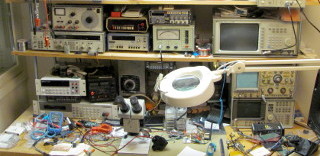
- The desk was bought used and has been with me over 20 years. It is a bit worn, but sturdy as hell.
- I added shelves to it to house all my test equipment. Threaded rods carry all the weight and allow easy adjustment as well.
- With a good fluorescent light and an ESD mat, it's a good place to tinker. The shelves also are plenty sturdy.
- Yet it was dirt cheap compared to a real Treston or similar workbench!
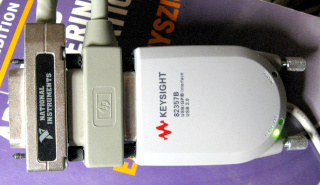
- To control the HPIB (a.k.a. GPIB or IEEE-488) enabled instruments, I had a junk-pile PC fitted with a Keithley KPCI-488 Interface Card that was also picked up from a junk pile. Curse modern PCs that no longer have the "legacy" PCI bus...
- Then I found a cheap (possibly counterfeit?) Agilent/Keysight 82357B USB-GPIB host adapter from eBay, and set it up with a Raspberry Pi both to control the various instruments, but also to interface between my Siglent oscilloscope and my Agilent RF generator, enabling them to do Bode plots.
- I made a couple of simple Python scripts to use these instruments over GPIB (or Ethernet/VXI-11 or USB/USBTMC or Serial/RS232) using PyVISA. If you think they'll help you get started, you can look at them here.
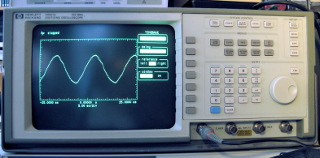
- Obtained free, "broken"
- 100 MHz bandwidth, 4 channels
- 10 MSa/s sample rate—higher frequency signals must be repetitive
- HPIB bus, through which I can get screenshots through my Raspberry Pi GPIB and web server
- Huge range of automatic measurements, but no Tetris????? (The HP 54600 series does have Tetris. Damn.)
- Repairs done: Replaced dead battery-backup RAM and performed self-calibration routines.
- Total cost: 20 eur!
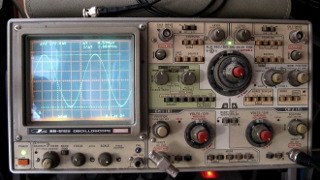
- Bought used, with hard currency
- 100 MHz bandwidth, 4 channels, triggers reliably to over 170 MHz (but does become impossible around 190 MHz).
- Dual timebase, dual trace, impressively low jitter!
- Cursor readout, frequency counter, everything except Tetris. (Again! Damn!)
- An absolutely fantastic instrument!!!
- A digital oscilloscope, with all its advantages and convenience, can only complement an analog one. It could never replace a top-notch analog scope like this one. (Just compare the number of buttons and knobs with the above digital scope!)
- If you have the Service Manual, please let me know! (Though hopefully I will never need it.)
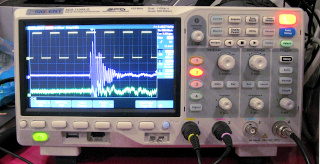
- This one I bought brand spanking new, having decided finally to upgrade to the current millennium. HP 54501A, move over! :)
- 100 MHz bandwidth, 4 channels, dual 1 GSa/s or quad 0.5 GSa/s, 2×14 M or 4×7 M sample memory
- USB and Ethernet connectivity, 1 MSa FFT, Bode plot, ... Oh, go read the spec sheet yourself!!! Still no Tetris, though... :(
- Modifications done: None. I have not attempted to unlock the 200 MHz bandwidth (yet), because I have no need for it. Rumor has it, the PP510 probes provided with the 100 MHz SDS1104X-E aren't too great at 200 MHz, but I do have a pair of excellent 350 MHz Iwatsu SS-082R probes that would fit the bill.
- By using a GPIB-equipped Raspberry Pi as an interface, the Siglent will do Bode plots using my Agilent E4421B (or possibly any RF generator that understands SCPI commands) or my HP 8904A as a signal source!
- I may give away my old HP 54501A, but I'm keeping my old analog Iwatsu!
- Are you in need of 50Ω inline terminators? BNC tees and terminators from old 10base2 networks will work just fine!
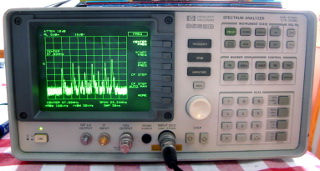
- Salvaged from junk pile
- Swept-frequency triple-superheterodyne architecture
- Frequency range originally 1 kHz–22 GHz in five bands, now only to 2.9 GHz
- Option for external mixer
- Resolution bandwidth 1 MHz to 100 Hz
- HPIB bus (Here's how to get a screenshot from the 8562B over the HPIB interface!)
- Repairs done: Replaced broken front-end mixer with a Mini-Circuits ZX05-U742MH-S+. Currently only low-band (up to 2.9 GHz) works. Replaced missing rotary control knob with one from an old Nokia monitor.
- Total cost: 50 eur! I've seen an identical instrument (though fully working) going for 6500 eur!
- I need to build a tracking generator for this
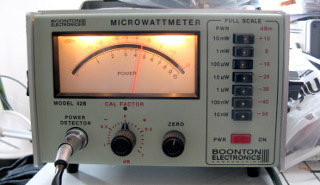
- With 41-4A detector
- Frequency range 200 kHz–7 GHz
- Power ranges –50 dBm...+10 dBm full-scale
- Really nice Ye olde scientific instrument. Gotta love the pale-green Boonton front face!
- The power readings agree very well with my HP/Agilent 4421B
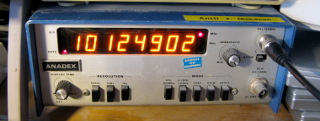
- Frequency ranges 5 Hz–100 MHz, 0.1–1.0 GHz
- 100 / 10 / 1 Hz resolution
- "Avionics test equipment", according to the sticker :)
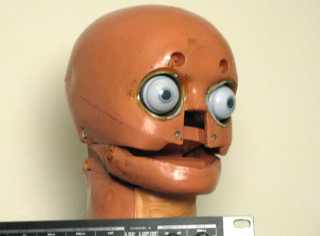
- Very, very awful, yes.
- Extremely high quality
- f(3dB) from 1.72 to 3.14 MHz, overrange from below 1 MHz to almost 4 MHz
- Repairs done: Cleaning and basic calibration
- I need to install an HPIB interface and a flappy tongue
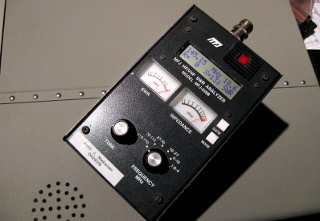
- Frequency ranges: 1.8–4, 4–10, 10–27, 27–70, 70–114, 114–170 MHz
- Output level: Approx. +9 dBm on all ranges
- Yes, it really is great for tuning antennas
- With a loop of wire, it works as a dip meter (for tuning traps etc.)
- Repairs and mods: Reattached dislocated analog meter, added rubber protector ring around power switch to avoid inadvertent switching on
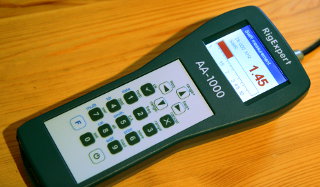
- Frequency range from 100 kHz to 1 GHz
- Extended frequency range with PC software
- Numerical and graphical display of SWR or resistance and reactance
- Smith Chart display, FFT TDR function, everything except Tetris
- Runs on three AA-batteries (opposed to ten AAs in the MFJ 259B) with excellent battery life
- Here's some notes about this fine instrument
- How to update the firmware under Linux, and Why RXTX-Tuote sucks
- Modifications done: Updated the firmware, glued some open-cell foam inside the battery compartment lid
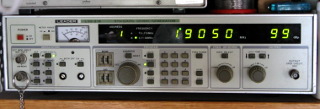
- Obtained cheap, malfunctioning
- Frequency ranges 0.1–30 MHz, 75–115 MHz
- Output level –10...+99 dBuV
- CW, AM and FM modulation
- Internal (400/1000 Hz) or external modulation source, pilot/stereo/L/R/main/sub channels on FM
- Repairs done: Replaced malfunctioning relays in output attenuator
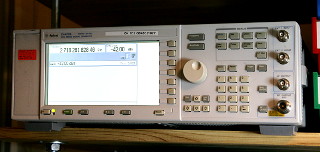
- Bought used, with hard currency
- Frequency range 250 kHz–3 GHz (underrange down to 100 kHz)
- FM, phase, AM and pulse modulation, Internal generator for modulation signal; also doubles as AF function generator
- HPIB bus, which I use to interface to my Siglent oscilloscope to do Bode plots
- I think this is the closest I can get to an RF amplitude reference, and at least the Boonton agrees with it to a fraction of a dB.

- Frequency range 10 Hz–100 kHz
- Sine and square wave outputs
- Isolated sine output
- Nice gear-reduction frequency dial. (Or, as I was later told, a backlash-free ball bearing drive, even nicer!)
- Ye olde all-analog design, way cool...
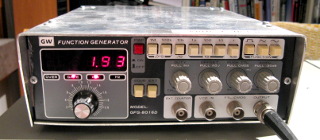
- Also sold under Instek and Elenco brand names
- Obtained cheap, chassis made of duct tape
- Triangle, square and sine wave outputs
- Frequency range 0.2 Hz–2 MHz
- Amplitude 0–10 Vpp, offset +/– 5 V to 50 ohms
- Digital frequency counter
- Repairs done: Rebuilt broken chassis
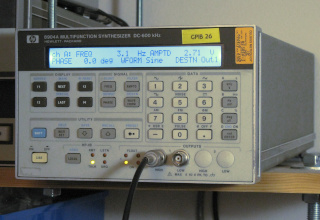
- Sine output from DC to 600 kHz, other waveforms to 50 kHz
- Triangle, square, ramp, sine, noise, and DC signals on four internal channels
- Summation of internal channels to output; FM, AM, phase, DSB and pulse modulation of output using internal channels; simultaneous modulation using multiple internal channels; modulation by summed signal of multiple internal channels, tone / DTMF / digital sequences; omg this is so confusing...
- Single-ended (ground referenced) or dual-ended (floating) output
- HPIB bus, which I use to interface to my Siglent oscilloscope to do Bode plots
- Repairs done: Replaced the LCD display and the RAM backup battery

- Voltage range 0–20 V
- Adjustable current limit 0–5 A
- Programmable overvoltage and overcurrent protection
- HPIB bus
- Modifications done: Custom front panel output modification
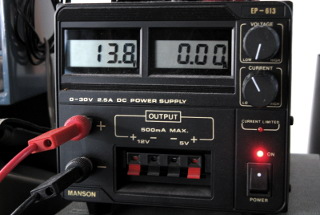
- Voltage range 0–30 V
- Adjustable current limit 0–2.5 A
- Fixed 5 V and 12 V outputs at 500 mA
- Probably the exact same device is also sold as Lion EP-613, DCSS EP-613 and Rapid PS3025, possibly many others
- Modifications done: Custom modified with multi-turn potentiometers for more precise voltage and current adjustment
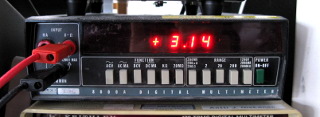
- Obtained cheap, "unknown condition"
- 3 1/2 digit display
- A reliable no-frills workhorse
- Repairs done: Replaced amp-range fuse, checked calibration

- Obtained cheap, "seems to work"
- 4 1/2 digit display
- True-RMS measurement
- Same input connector is used for both voltage and current ranges—stupid! :(
- Repairs done: Calibration
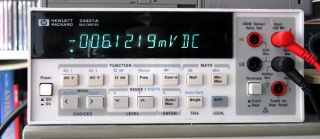
- 6 1/2 digit display
- Autoranging
- True-RMS measurement
- 4-wire resistance or voltage ratio measurement
- Selectable front and rear connectors
- HPIB bus
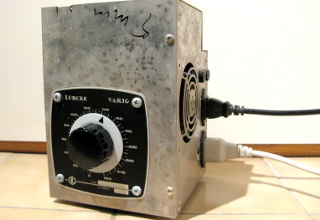
- Salvaged from junk pile, perhaps unused???
- Output voltage range: 0–260 V (for 230 V input)
- Current rating: 2.5 A
- Does not provide isolation :(
- Repairs done: Installed the naked variac in a new chassis (old PC power supply), with appropriate connectors and fuses
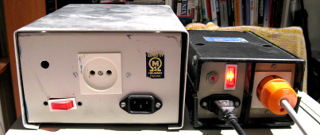
Isolation Transformers
- Rated at 1 kVA and 200 VA, respectively
- Repairs done: Rebuilt chassis on 1 kVA unit, installed on/off switches on both units

- Rubidium atomic clock, 10 MHz frequency
- GPS time standard (OEM model), 10 MHz frequency, PPS and data out
- Repairs done: Installed both modules in a single chassis, built regulated power supplies for both.
- I need to build a status display and PC interface for these, and eventually a distribution amplifier.
- With a huge LED display, this might also become my radio station's UTC-clock.
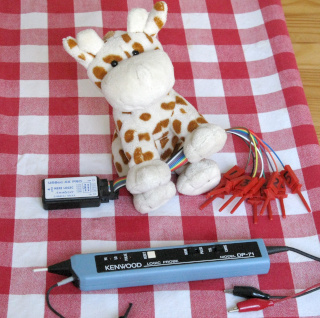
- Eight channels in a USB interface
- Works with sigrok
- Modifications done: Exchanged the 74HC245 chip with a 74LCX245, which is 5V-tolerant
- The furry cow is not an original accessory
Kenwood DP-71 Logic Probe
- TTL / CMOS voltage ranges
- Pulse detect function
- Surprisingly useful for detecting transient signals that an older oscilloscope couldn't see (before I got my Siglent)!
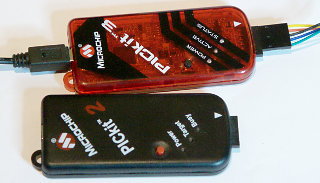
- One usbpicprog device
- One PICkit2 from Microchip
- One PICkit3 from Microchip, which apparently is a debugger also
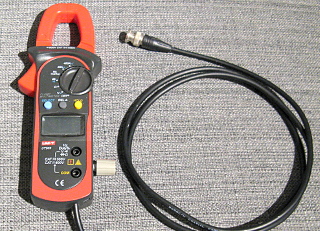
- Very cheap, with 40 A and 400 A current ranges, AC and DC
- Digital display for readings, but no analog output
- Modifications done: Added an analog output that can be connected to an oscilloscope
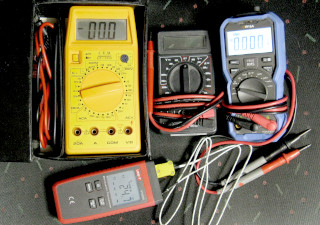
- I have a bunch of cheap no-name multimeters as well. They're not fancy, and have "only" 3 1/2 digits, but the oldest one (25+ years now) is still working, and accurate almost to one digit. The cheapest one cost 2 eur on sale brand new. There's no reason not to have a multimeter in every single tool box, radio bag and other go-kit. You always end up needing one whatever you do and wherever you are!
- The Owon OW16A and OW18A are fine "3 5/6 digit" handheld multimeters (display reads up to 5999 instead of 1999, which is "3 1/2 digits"), one of which I keep within arm's reach at all times. They have auto ranging, true-RMS, capacitance and frequency measurement, thermocouple temperature readout, backlighted display etc, even non-contact mains voltage sensing as a bonus!
- The UNI-T UT320D is a simple two-channel thermometer for K-type or J-type thermocouples, with a range of −50°C to +1300°C. I initially got it for calibration of my electric smoker (I did not have the Owon multimeters yet).
- I picked up a Parkside PTI 380 C2 infrared thermometer on the cheap in Lidl once. It's simple and stupid, range −50 to +380°C, has the usual laser pointer, and a rather useless "reference temperature" function (to tell if something is hotter or colder than an earlier set reference—who cares, I just want temperature readings). Reasonably accurate too, on most surfaces (even windows or glass mirrors—it definitely seems to measure the temperature of the glass, not whatever is visible beyond—just as an IR thermometer should). A thermal imaging camera would be cool (no pun intended), and they're relatively cheap nowadays. I just don't know what I'd do with one.

- I have an ultra cheap "Aliexpress grade" component tester, an LCR-T4 or a Mega328 or some such (it calls itself "MTester" upon powering up). It's not bad for what it is—an MCU, an LCD, and very little else—the firmware source code might be interesting to peruse, though... (Wait, have these originally been born out of an open source project?) It's easily good enough to check the color, polarity and voltage drop of a single or dual LED, and whether a BJT or MOSFET is working or not, or to identify the pins on a mystery transistor. The breakdown voltage of Zeners will not be perfectly accurate, as they're meant to be biased with a specified current—a random 4.3 V Zener tested as 3.86 V—and a 5.1 V Zener was identified as an ordinary diode, so the maximum test voltage is somewhere between those, despite the device being powered by a 9V battery (probably regulated to 5V, I'd guess, and test voltages might max out at a diode drop below that). Resistors and capacitors are measured just fine, and inductors are black magic in any case...
- I got myself an el-cheapo Fnirsi LCR-ST2 tweezer-type multimeter just for the convenience of checking SMD components. It's actually a fairly sophisticated instrument, with the ability to measure voltage, resistance, capacitance, inductance and diode voltage drop, as well as parameters like reactance, phase angle and Q-value. It offers series and parallel models for measuring RC and LC circuits, has selectable measurement voltages and frequencies, and it even has Kelvin (4-wire) connections to do measurements with! My desktop HP/Agilent 34401A also offers 4-wire measurement, but you never see it on hand-held multimeters! I wonder why not, as it really adds very little complexity to the device. This one came with a dedicated wire harness with clamps for making the 4-wire connection. The tweezer bit pulls right off, and the wire harness plugs in its place. The connector is actually a standard USB-A, so you can easily whip up alternative 2 or 4-wire connections as well.
- There's also a Joy-IT JT-AT34 USB "multimeter" for monitoring the voltage and current put out by a USB port, as well as power, total accumulated charge and energy, and various quick charge information. Not really useful for anything else than monitoring USB charging or checking the power consumption of USB devices, but those would be rather tedious without a dedicated device. This one passes data at full USB 3.0 speed, and measures voltages up to 30 V and currents up to 4 A. The display is tiny—a magnifying glass ought to be provided as a standard accessory! And, love it or like it, USB-C is here to stay, so I eventually had to get a similar USB-C multimeter, the Keweisi KWS-1902C. Apart from its connectors, it's pretty much the same as the Joy-IT device. The two devices show pretty much the same voltage, but their current readings (and therefore capacity as well) differ by some 3%. Not too shabby for such cheap toys. I've yet to do a full MSA against my HP 34401A.